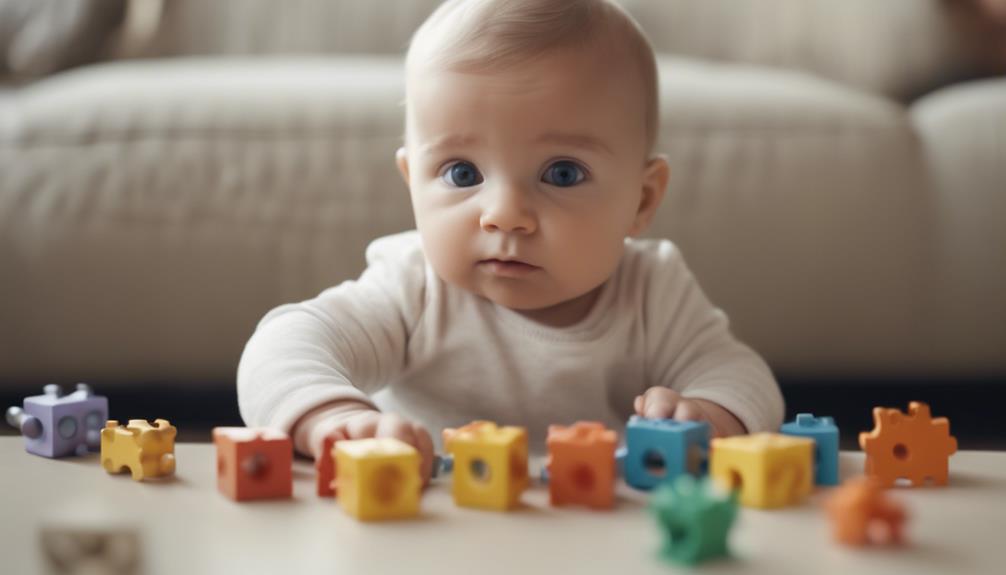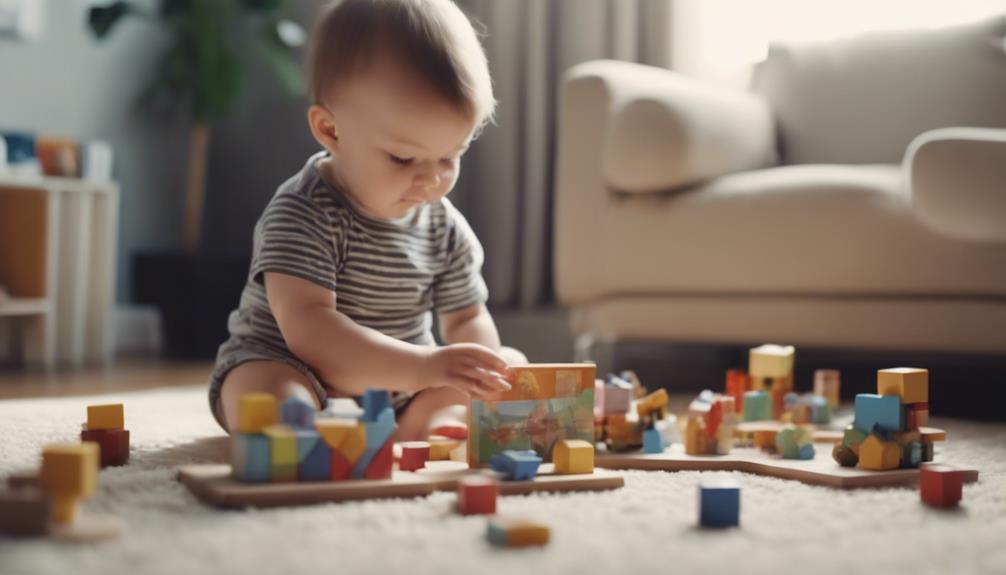To determine if your baby is happy, look for these indicators: smiling, cooing, giggling, eye contact, excited movements, calm behavior, content expressions, playful interactions, and responsiveness to stimuli. When your baby smiles, makes happy noises, and maintains eye contact, it typically indicates they are content and secure. Moreover, engaging in playful interactions and showing responsiveness to their surroundings show happiness. Take note of these cues as they offer important insights into your baby’s emotional state, enabling you to establish a supportive atmosphere. These signs reflect your baby’s welfare and can strengthen your connection.
Key Takeaways
- Smiling, giggling, and playful interactions demonstrate happiness.
- Engaging with toys, making eye contact, and reaching out signify joy.
- Vocalizations, joyful responses, and active movements reflect contentment.
- Playful interactions, like cooing and babbling, indicate a happy baby.
- Positive facial expressions, attentive gaze, and frequent eye contact show well-being.
Smiling
Watch for your baby's smiling as a crucial sign of happiness and contentment. Baby smiles aren't just adorable; they're essential cues to your little one's emotional well-being.
When your baby smiles in response to interactions, funny faces, or tickles, it shows they're happy and engaged. Even newborns exhibit smiles during sleep or after passing gas as a natural response to comfort. These smiles reflect the emotional connection and positive interactions your baby experiences with caregivers.
By observing your baby's smiles, you gain valuable insights into their happiness and overall state of being. So, cherish those precious moments when your baby grins from ear to ear, as it signifies a content and joyful baby who feels safe and loved.
Cooing

When your baby starts cooing, it signals contentment and pleasure in their interactions. Baby cooing is a delightful vocalization that indicates your little one is happy and engaged.
These soft, melodic sounds often emerge in response to soothing sounds or voices, showcasing your baby's emotional connection and overall happiness. Cooing is a positive communication cue in infant development, demonstrating their enjoyment of the moment.
As your baby coos, they're expressing their comfort and satisfaction with the interaction at hand. This vocalization is a natural way for babies to communicate their contentment and joy.
Paying attention to your baby's cooing can provide you with valuable insights into their feelings and emotions, allowing you to respond appropriately to their needs and strengthen your bond with them.
Enjoy these sweet moments of baby cooing, as they're a beautiful sign of your little one's happiness and well-being.
Giggling
When your baby starts giggling, it's a clear sign of happiness and delight.
Those infectious bursts of laughter show that your little one is feeling joyful and amused.
Encourage these joyful giggles through playful interactions and watch your baby light up with happiness.
Infectious Baby Laughter
Infectious baby laughter, also known as giggling, is a heartwarming indicator of your infant's happiness and joy. This delightful sound typically emerges around 3-4 months of age, showcasing your baby's emotional connection and pleasure in the world around them.
Baby laughter is more than just a noise – it serves as a form of communication and social interaction that strengthens the bond between you and your little one. When you hear your baby giggle, it not only brings a smile to your face but also to those around you.
The infectious nature of baby laughter can evoke positive emotions and create a sense of happiness in the environment. Encouraging and observing these joyous giggles can contribute to a loving and cheerful atmosphere for both you and your baby, fostering a nurturing relationship filled with shared moments of laughter and delight.
Joyful Giggles and Coos
Babies often express their happiness through joyful giggles and coos, delightful sounds that indicate their contentment.
When your baby giggles, it's a positive sign of emotional well-being, showcasing their capacity for joy and pleasure.
Coos, those soft and melodic sounds your baby makes, serve as a way to communicate happiness and engage with you, their caregiver.
As your baby gazes up at you and lets out those adorable sounds, they're sharing their happiness with you.
Responding to your baby's giggles and coos with smiles and positive interactions can help strengthen the bond between you and your little one.
By paying attention to the frequency and context of these sounds, you can better understand and respond to your baby's happiness.
Eye Contact
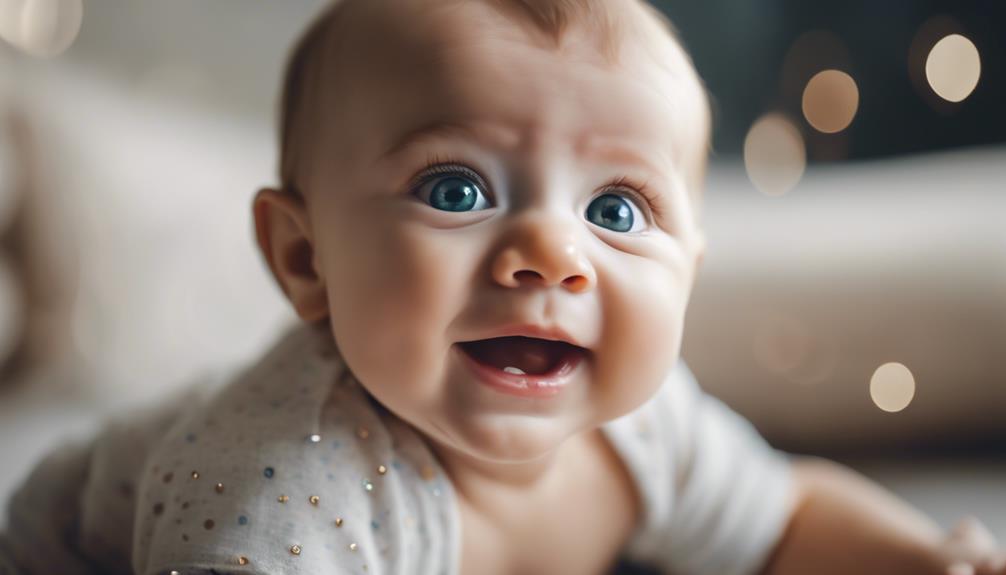
Eye contact serves as an essential indicator of your baby's happiness, demonstrating their engagement and connection with you as their caregiver. When your baby makes eye contact with you, it shows that they are content and secure in their environment. This simple act can help strengthen the bond between you and your little one, fostering a sense of trust and understanding. Studies have highlighted the significance of eye contact in a baby's emotional development and communication skills, making it a vital aspect of their early interactions.
To help you better understand the importance of eye contact in gauging your baby's happiness, take a look at the table below:
| Signs of Happy Baby's Eye Contact | Explanation |
|---|---|
| Frequent eye contact | Demonstrates contentment and security |
| Attentive gaze | Signals happiness and well-being |
| Interest in making eye contact | Indicates engagement and emotional connection |
Excited Movements
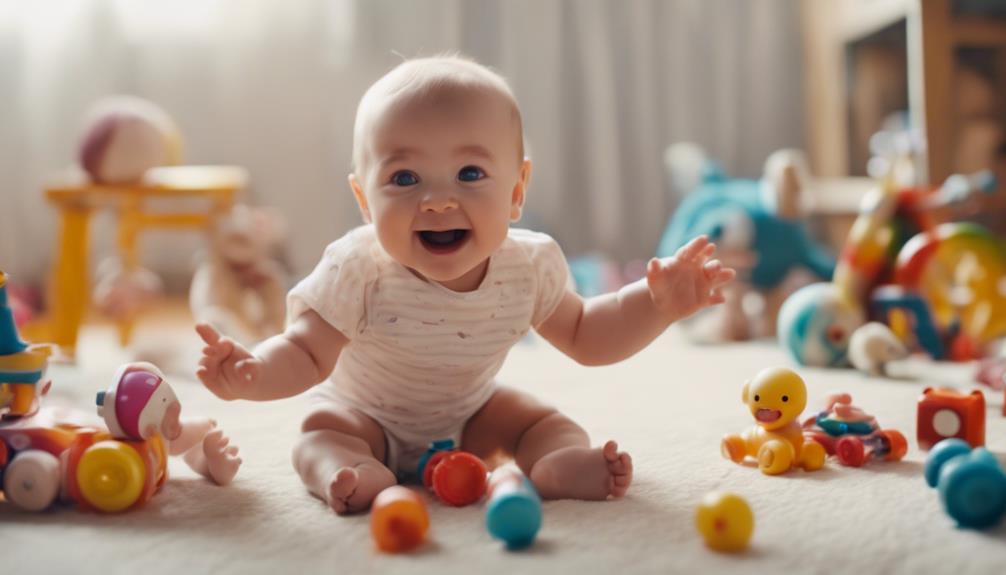
Excited movements displayed by happy babies often include kicking their legs, waving their arms, or bouncing up and down. When your baby is feeling joyful and content, you may notice them clapping their hands, reaching out towards objects, or eagerly grabbing toys. These movements are clear indicators of their happiness and excitement.
Additionally, smiling, giggling, and laughing are common signs that your baby is thoroughly enjoying their playtime or interactions with you. Through babbling, cooing, and making joyful sounds, babies express their happiness and delight in various ways.
Reaching Out

Displaying curiosity and engagement, reaching out is a common behavior in happy babies, signaling their positive emotional state and desire for interaction.
When your baby extends their arms or hands towards toys, objects, or caregivers, it demonstrates a keen interest in exploring their surroundings and connecting with the world around them.
This gesture not only shows a willingness to engage but also signifies a sense of contentment and well-being.
As your little one reaches out, you may notice accompanying expressions of joy such as smiling, cooing, or babbling, further highlighting their happiness.
By observing these actions, caregivers can gain valuable insights into the emotional state of their baby and understand their desire for interaction and exploration.
Calm Demeanor
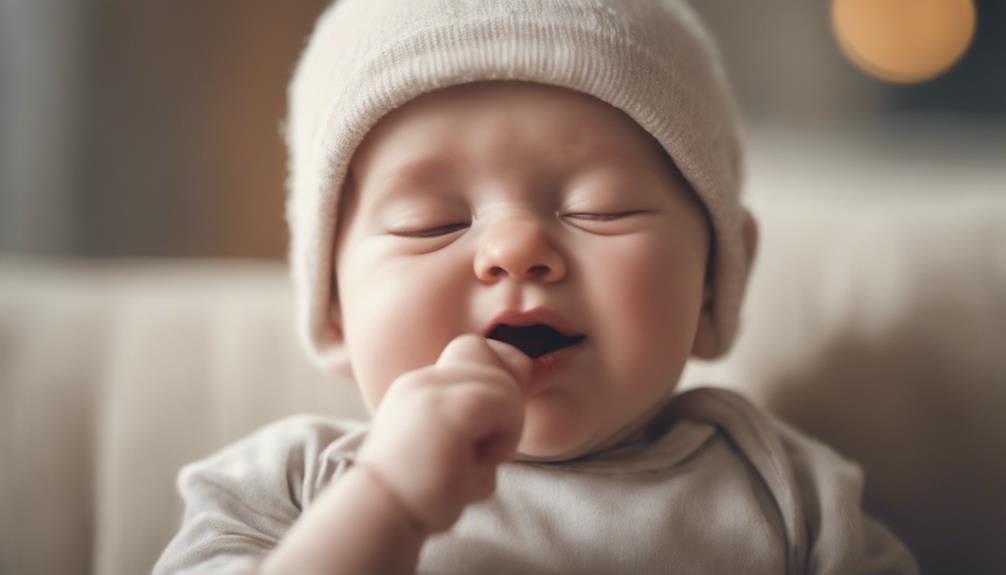
A baby's calm demeanor often signals their contentment and happiness, reflecting a peaceful and tranquil presence.
When observing your baby, pay attention to their facial expressions and body language. Happy babies typically exhibit relaxed features, such as soft smiles, gentle eye contact, and a serene expression. Look for open hands, relaxed arms, and a generally calm posture.
The tranquility in their demeanor may be accompanied by soothing sounds like gentle cooing or soft sighs, further indicating their state of contentment. A calm baby is often a happy baby, and witnessing this peaceful composure can be a reassuring sign of their well-being.
By recognizing these subtle cues in your baby's behavior, you can better understand their emotional state and respond appropriately to nurture their happiness and comfort.
Content Expressions
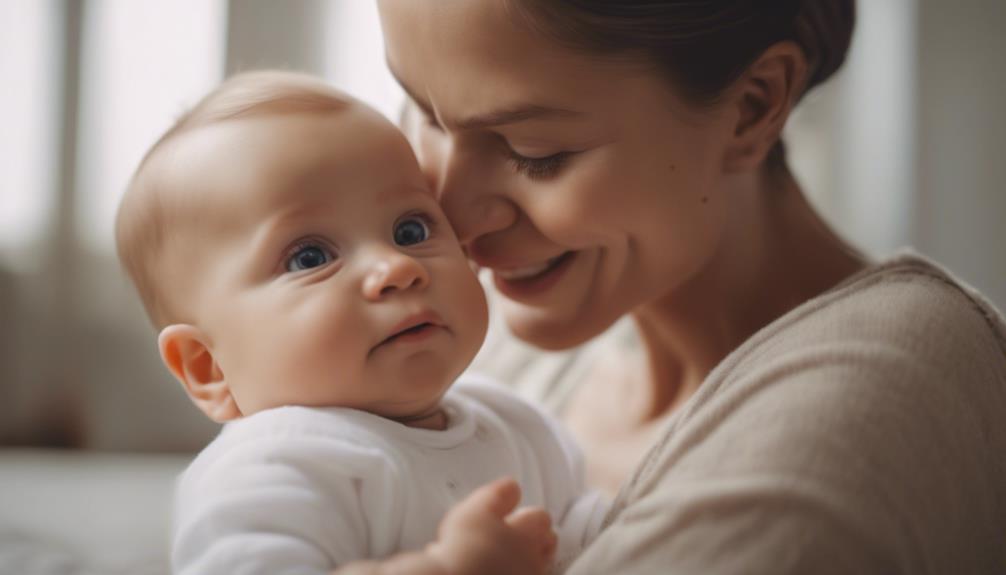
When your baby smiles and giggles, engages in playful interactions, and maintains content sleep patterns, these are clear indicators of their happiness.
These content expressions show that your baby is feeling joyful, connected, and at ease in their environment.
Smiles and Giggles
To gauge your baby's happiness, observe their frequent smiles and giggles as they interact with you. Happy babies often express their joy through these positive facial expressions, indicating contentment and emotional well-being. When you engage with your baby and see them responding with smiles and giggles, it shows that they're enjoying the interaction and feeling connected to you.
Babies may smile in response to funny faces, tickles, or playful interactions, signaling their pleasure and comfort. Even during sleep or after passing gas, newborns might display smiles, reflecting their peaceful state and contentment.
Recognizing these smiles and encouraging them can further strengthen the bond between you and your baby, fostering a sense of security and happiness.
Playful Interactions
Engage with your baby through playful interactions to observe their content expressions, such as grinning and giggling, which are clear indicators of their happiness. When you interact with your baby in a playful manner, you can witness their joy and contentment through various signs:
- Smiling, Cooing, and Babbling: A happy baby will engage in playful interactions by smiling, cooing, and babbling with enthusiasm.
- Grinning and Giggling: Content expressions like grinning, giggling, and lighting up indicate a baby's happiness and enjoyment during playful interactions.
- Playful Eye Contact: Playful eye contact and attentive looks are signs of a baby's interest and happiness in interactions.
- Vocalizations and Joyful Responses: Baby's vocalizations, squeals of delight, and joyful responses during play signify a happy demeanor.
Content Sleep Patterns
Observing your baby's content sleep patterns can offer valuable insights into their emotional well-being and overall happiness. Baby sleep plays a significant role in their development and happiness. A happy baby often exhibits deep and restful sleep, contributing to their overall well-being.
Content expressions during sleep, like peaceful facial features and relaxed body language, signify comfort and happiness. By monitoring your baby's sleep habits, you can gain insights into their emotional state and level of contentment.
It's important to watch for signs of restlessness or disturbances during sleep, as this can indicate potential issues affecting your baby's happiness and comfort. Content sleep patterns are essential for promoting physical development, emotional well-being, and a happy disposition in babies.
Playful Interactions
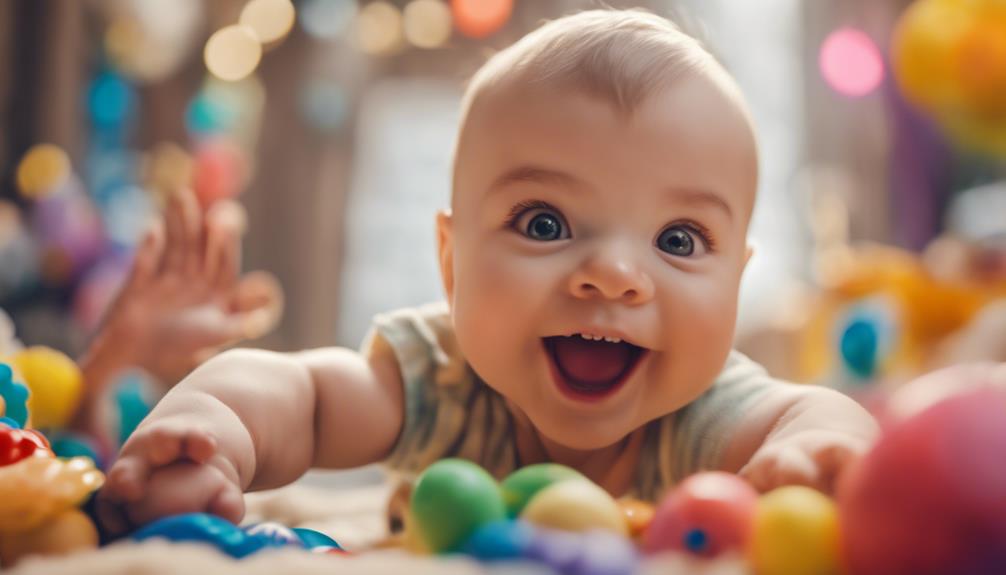
Look for signs of happiness in your baby through playful interactions, such as smiling, giggling, and engaging with toys or you. When your little one is having a good time, they'll show it in various ways.
Here's what to look out for:
- Smiling: A happy baby will flash those adorable little smiles during playtime.
- Giggling: The sound of your baby's giggles is a clear indicator of joy and amusement.
- Engaging with Toys: Watch as your baby interacts with toys enthusiastically, showing interest and excitement.
- Interacting with You: Your baby's happy interactions with you, like reaching out or making eye contact, demonstrate their joy.
These playful interactions are key indicators of a happy baby. Pay attention to their body language, vocalizations, and overall demeanor during playtime to gauge their happiness levels accurately.
Responsive to Stimuli
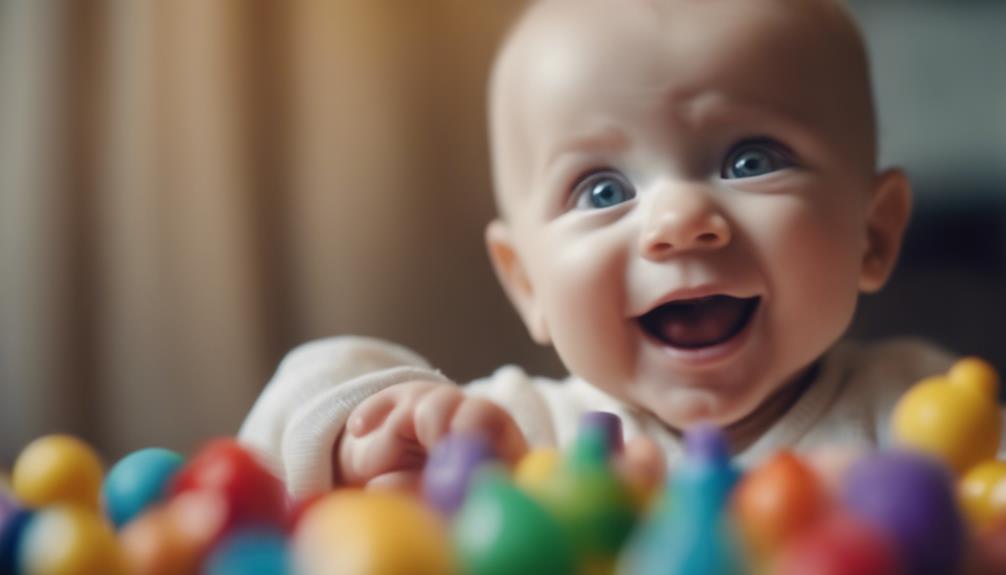
When your baby is happy, they'll actively engage with their surroundings, responding to sounds, movements, and visual stimuli.
You'll notice positive facial expressions, such as smiles and bright eyes, indicating their enjoyment and contentment.
Pay attention to these cues as they interact with the world around them, showing their happiness through their reactions and responses.
Active Engagement Cues
A key indicator of your baby's happiness is their active engagement cues, which involve responsive behaviors to stimuli. When observing very young babies, pay attention to the following signs:
- Look for signs of active engagement in your baby, such as attentive eye contact and interest in their surroundings.
- Notice if your baby responds with smiles, grins, or vocalizations when interacting with you or their environment.
- Watch for cues like reaching out for toys, kicking their legs in excitement, or babbling in response to stimuli.
- Pay attention to your baby's body language, like leaning in towards interesting objects or people, as a sign of engagement.
These cues are vital in understanding your baby's emotional state and level of happiness.
Positive Facial Expressions
Positive facial expressions are key indicators of your baby's happiness, particularly when they're responsive to stimuli. Very young babies often show their joy through smiling, grinning, and lighting up when engaged with their surroundings. Watch for bright, attentive looks in their eyes and a relaxed, content expression on their face as they interact with you or their environment.
When a baby smiles, coos, and babbles during interactions, it's a clear sign of their happiness and engagement. You may notice how their face lights up when they're delighted, showing joy and pleasure in the moment. Pay close attention to your baby's facial expressions during play, feeding, and interactions to gauge their level of happiness and contentment.
These cues can provide valuable insights into your baby's emotional state and help you understand their needs and preferences better.
Frequently Asked Questions
How to Know if an Infant Is Happy?
To know if an infant is happy, observe their body language for signs of contentment like good muscle tone, eye contact, and smiling. Look for regular bowel movements, feeding cues, and responsiveness to sounds.
How Do I Know if My Baby Is Satisfied?
To know if your baby is satisfied, watch for good muscle tone, regular bowel movements, and deep sleep. When content, babies display smiles, cooing, and playful interactions. A happy baby's enthusiastic babbling and toy play are clear signs.
What Determines a Happy Baby?
You can tell if a baby is happy by observing their smiles, giggles, and eye contact. Look for regular bowel movements, responsive behavior, and positive interactions. A content baby holds their body well and gazes into your eyes.
How Do You Know a Baby Feels Secure and Happy?
You know a baby feels secure and happy when they make joyful sounds, gaze at you with trust, have relaxed body language, sleep well, and show interest in play and surroundings. These signs indicate a content and happy baby.
Conclusion
To sum up, by recognizing the signs of a happy baby such as smiling, cooing, and playful interactions, you can guarantee that your little one is content and thriving. Remember, a happy baby is a healthy baby, so keep an eye out for these positive behaviors.
Just like a compass points north, these signs will guide you in the right direction towards a happy and well-adjusted baby.


